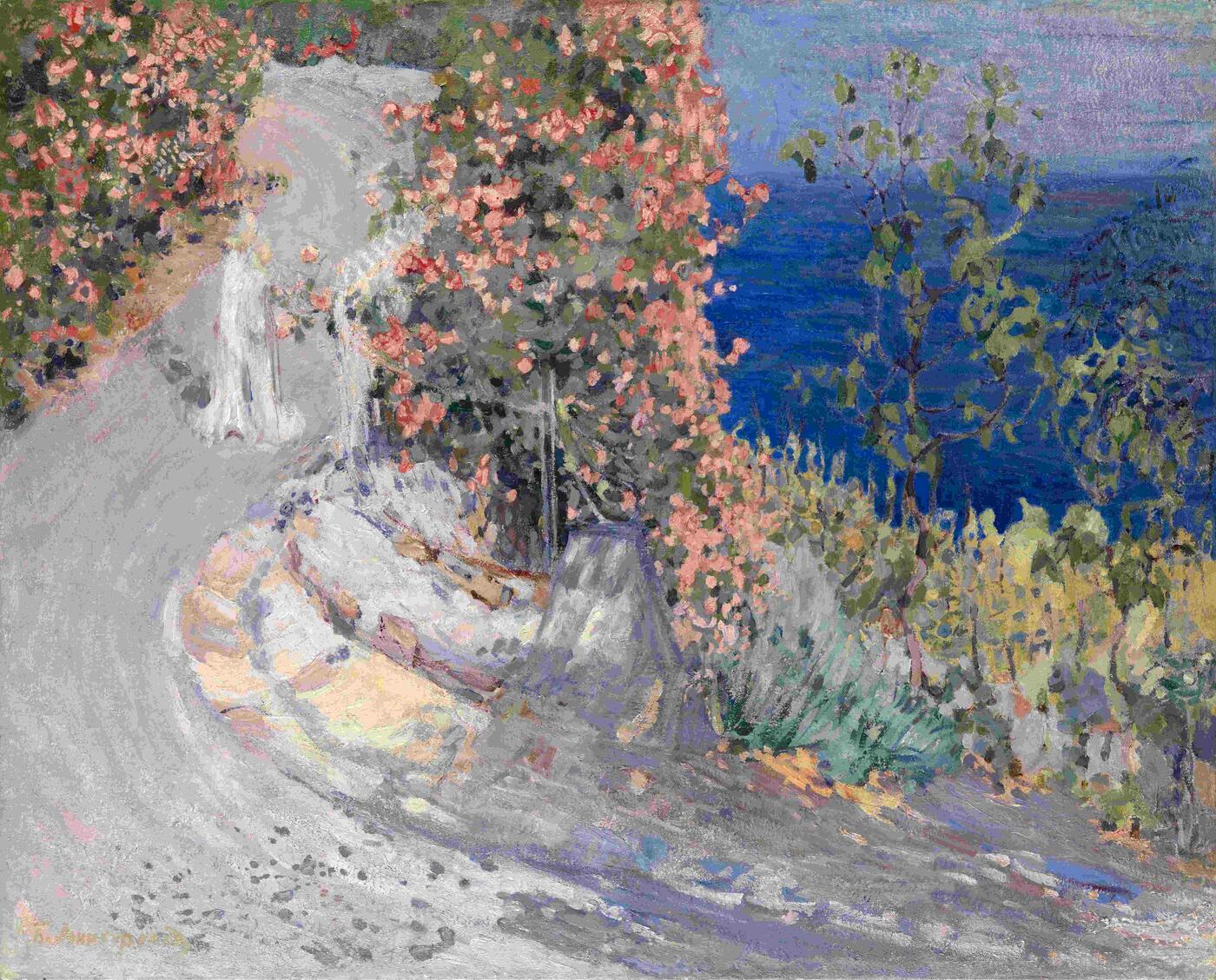MacDougall's Russian Art Auctions 1-2 Dec 2010
1 December 2010

* 363. ANISFELD, BORIS 1879-1973
Livadia signed and dated 1906
Oil on canvas, 80.5 by 100.5 cm.
250,000-400,000 GBP
Authenticity has been confirmed by the grandson of the artist Charles Chatfield-Taylor.
Authenticity has also been confirmed by the expert D. Volyak.
The year 1906 was a turning point in Anisfeld’s creative destiny. Until recently just an academic drop-out, he had been embarking on a journey through the Crimea, where he produced his first independent works full of colour and air. Expressed in the modernist style, these refined landscapes immediately revealed the true nature of Anisfeld’s talent. "A St Petersburger and product of our Academy, Anisfeld came from the same Blue Rose circle as Sudeikin. From vague moods of artistic symbolism, both mystical and ethereal, from the mist of the artistic world, spectres and visions, there arose both the affected grace of Sudeikin and the colourful ardour of Anisfeld", wrote the journal Stolitsa i usadba (Capital and Estate). However, through exceptional decorativeness and composition, the real inspiration of the artist is discernible in many of the Crimean landscapes. In Livadia this is the famous Tsar’s path running along the sea from the imperial Livadia palace past the Oreanda, along which wanders the ethereal white figure of a woman, imparting a clear tone of symbolism to the picturesque air of emancipation of the rich impressionistic landscape. "Being drawn from the real world into fantasy" is felt especially in areas where the artist "portrays nature", remarked Vsevolod Voinov: "He transforms this nature; it passes through, if it can be so expressed, a crucible of colourfulness. He exhibits delicate colours that are amazing in their boldness and force of composition, which immediately draws a distinct boundary between nature as it is and nature as it is portrayed through the lens of his creative vision".
Livadia, unlike many of Anisfeld’s Crimean landscapes and works of the Blue Rose group, the style of which the artist is so close to, was painted not in tempera, but in oil, which gives richness and tangibility to the texture of the canvas. It should be noted that the incredible intensity of colour, as well as the remarkable lightness and at the same time profoundness of the painting are not yet products of Anisfeld’s artistic perspective; rather, these features are determined by the composition itself, with its bright and sun-soaked Crimean landscape in spring.
It may be just this special relation to colour, first evident in canvases brought from the southern districts of Russia, in conjunction with the fantastic nature of Anisfeld’s painting, that interested Sergei Diaghilev, who was seeking new talent for the next World of Art exhibition. Igor Grabar was the first to discover the would-be artist, introducing him to Diaghilev in 1905. It is difficult to say whether Anisfeld, as he set off to the Crimea, was thinking of working on pictures for the upcoming exhibition. In any case, when Diaghilev visited Anisfeld’s studio upon the artist’s return from the trip, he became so impressed by what he saw that he selected twenty works on the spot.
"True, Diaghilev put on an excellent exhibition. The 'old men' – Serov, Maliavin, Somov — presented magnificent works. The 'youngsters' – Kuznetsov, Milioti, Anisfeld, and others who – although still searching – provided their 'own' exceptionally interesting works…", responded a rather conservatively-minded Mikhail Nesterov when recalling the 1906 exhibition. People started talking about Anisfeld. The critic Nikolai Tarovaty saw in Anisfeld’s Spring Evenings "a fabulous opulence of nuances", and Constantin Sunnerberg called his painting "a fairy tale of deep tones of scarlet, blue, emerald green, and yellow". Having attracted attention in his home country, Anisfeld also managed to please the Parisian maestros. At the end of the Autumn Salon of 1906, when by Diaghilev’s efforts the famous Russian Art Exhibition was organised, Boris Anisfeld, still enrolled as a student of the Academy of Arts, became one of seven Russian artists selected by current members of the Salon de Paris. This honoured title bestowed the right, once per year, without being subjected to the scrutiny of a selection panel, to exhibit at this prestigious showing. Success in Paris was reinforced at home: the Tretyakov Gallery acquired his still life painting Flowers, and famous collectors started to buy his works, with views of Crimea, some of which were acquired by Ivan Morozov for his collection, enjoying particular success.
All the success befalling the artist in 1906 was soon to be complemented by an invitation from Vsevolod Meyerhold to try his hand in the theatre. Anisfeld was starting work at the St Petersburg theatre of Vera Komissarzhevskaya on his first show, Zobeida’s Wedding, in which he managed to convey the compelling exoticism of the Near East, largely with the aid of surprising combinations of colours inspired by impressions from Crimean khanate palaces.
In his early theatrical decorations and artistic compositions, such as Livadia, Anisfeld with stunning harmony combines two underlying artistic trends of the time. On the one hand, he remains true to the pictorial principles of the Moscow symbolists. On the other, there is the "cult of colours" to which the artist leans, the gift and talent of the colourist placing Anisfeld’s works on the same level as the works of the best younger generation artists of the World of Art, and within a few years enabling him to be admitted to the cohort of stars of the legendary Russian Seasons.
Notes on symbols:
* Indicates 5% Import Duty Charge applies.
Ω Indicates 20% Import Duty Charge applies.
§ Indicates Artist's Resale Right applies.
† Indicates Standard VAT scheme applies, and the rate of 20% VAT will be charged on both hammer price and premium.